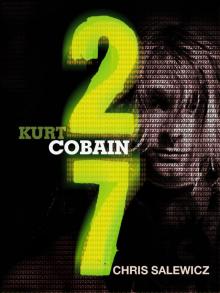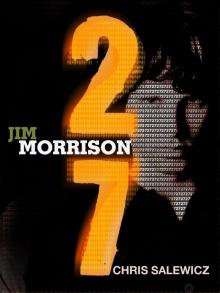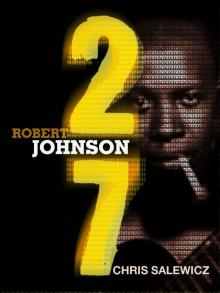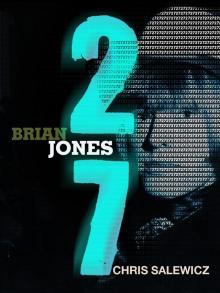- Home
- Salewicz, Chris
27: Robert Johnson Page 2
27: Robert Johnson Read online
Page 2
In the early 1920s, Dusty, Julia and her son crossed the Mississippi River to the town of Commerce. The two adults were employed on the Abbay and Leatherman plantation, and a wooden shack came with their jobs. By 1924 the fourteen-year-old Robert was registered at the Indian Creek school.[6]
On arriving at the school, he had demonstrated that he was already a very proficient musician. His contemporary, Willie Coffee, recalled that they would regularly play hooky from school, hiding under a local church. There Robert would ‘blow his harp and pick his old Jew’s harp for us and sing.’ When discovered by their teacher, as they inevitably were, the truant schoolboys would each receive five lashes. Although some would claim that Robert Johnson had no education whatsoever, Johnny Shines maintained he had beautiful handwriting, a product of his creative long fingers.
During this time Robert Johnson is recalled making a ‘diddley bow’, a wire stretched with nails, on the side of their plantation shack that abutted onto the levee. It would be played by hitting it with a stick as a glass bottle was slid along to change notes, and Robert would be heard playing on it late into the night.[7].
After playing around with the Jew’s harp, Robert moved on to the harmonica, playing it for the next few years until he bought an old guitar, so battered that it only had four strings – he saved up his pennies for the remaining two strings. Out on the edge of the road that ran alongside the levee holding back the waters of the Mississippi, as other kids played with marbles, he would struggle to play this instrument. One of his favourite songs, which he would strive to replicate, was ‘How Long, How Long Blues’, by Leroy Carr.[8] Taught by Harry ‘Hard Rock’ Glenn, he also learned one of his first guitar songs, ‘I’m Gonna Sit Down and Tell My Mama’.[9] In addition he picked up a certain ability with piano and pump organ.[10]
By now the clearly intelligent, quietly self-assertive boy was aware of his ancestry, and of his true name, which he began to use. He would slip away at night, travelling to nearby towns like Lake Cormorant, Pritchard and Banks, playing guitar in juke joints – frequently black-owned stores that converted at night into small semi-nightclubs. He would also travel up to Memphis, to spend time with Charles Spencer and his family.[11]
Wherever he went, however he travelled, Robert Johnson was known for somehow always looking well turned out, well pressed. As the guitarist Johnny Shines, with whom he would trek and play as a duo in the last years of his life, explained to Alan Greenberg, ‘We’d be on the road for days and days, no money and sometimes not much food, let alone a decent place to spend the night . . . And as I’d catch my breath and see myself looking like a dog, there’d be Robert, all clean as can be, looking like he’s just stepping out of church.’[12]
For his parents there were worries he might have been going off the rails. By contemporary standards his mother Julia, by then in her fifties, was considered aged – in 1920 life expectancy for non-white Americans, who were ninety per cent black, was only just over forty-five years. Yet together with her new husband Dusty Willis, Julia had endeavoured to imbue her son with solid, God-fearing values, setting him on a straight course, they hoped, for adulthood. Robert did not always get on with his step-father, however; Dusty Willis held no truck with the boy’s penchant for picking at his guitar, when instead he should have been out breaking his back picking cotton in the fields.
His fastidiousness about his on-the-road appearance was not necessarily reflected in other aspects of his demeanour; fond of a drop of moonshine, Robert was known to grow amorous under the influence of alcohol. Johnny Shines later recalled their needing to hotfoot it out of towns after Robert found himself becoming over-affectionate towards another man’s girlfriend or wife.[13] How must his parents have felt when in 1926, when he was only fifteen, Robert Johnson began a relationship with a divorced mother? The woman, Estella Coleman, was ten years older than Robert; was this perhaps a subconscious adherence to the pattern of behaviour displayed by his own younger father with his mother? And by her relationship with Dusty Willis, less than half her age? ‘Robert followed my mother home,’ Estella’s son said later about an affair that would continue, one way and another, for the next ten years.[14]
Estella Coleman’s son’s name was Robert Lockwood, Jr. He was only four years younger than his mother’s lover. When he was eight, Robert Lockwood had started to play organ in his father’s church. When Robert Johnson arrived with his guitar, however, he switched to that instrument. Whenever he put down his guitar and went out, Robert Lockwood would pick it up and try to copy what he had seen him doing. On discovering this, Robert Johnson resolved to tutor the younger boy, the only person whom the usually secretive Robert is believed to have so instructed. Robert Johnson even made Robert Lockwood a guitar. ‘The first thing he taught me,’ said Robert Lockwood, ‘was “Sweet Home Chicago” . . . He was like pennies from heaven for me, because he taught me how to make my living. My mother loved him and he taught me to play, so I have to say I loved him too.’[15] Later Robert Johnson would also teach him the rudiments of stage-craft. (The ultimate consequence of this exposure to his mother’s lover was that by 1948, after many years of assiduous application to his craft, during which time he himself had already become a celebrated blues musician, Robert Lockwood had been transformed into what Robert Palmer described in his 1981 book Deep Blues as ‘the Delta’s first modern lead guitarist’.[16] (As though repaying his debt of instruction from Robert Johnson, Robert Lockwood later taught guitar to the man who became B.B. King.)
Most other bluesmen worked in guitar duos, but ‘Robert came along and he was backing himself up without anybody helping him, and sounding good,’ Lockwood recounted in Deep Blues.[17] Lockwood’s assessment of Johnson’s playing differed from the common local view, which was utterly dismissive of his skills. Pounding the floor with his feet to push along the rhythm, Robert Johnson made his guitar sound as though it was being played by two men, somehow managing to simultaneously play rhythm and lead parts. His high, keening vocals, sometimes riding up to a reedy falsetto, were far from the deep baritones employed by many bluesmen. Still in his mid-teens, Robert was in the process of developing his style and abilities to a point where he would revolutionize the form.
He was surrounded by prospective mentors. Settled in the area, for example, was local bluesman Willie Brown, from whom Robert Johnson already had endeavoured to glean as many musical insights as he could. Robert emulated Willie Brown, learning some of his tunes, notably ‘The Jinx Blues’, and Willie Brown is referenced in Robert Johnson’s song ‘Cross Road Blues’, when Robert calls for help from his ‘friend Willie Brown’.
Willie Brown was an acquaintance of Charley Patton, born in either 1887 or 1891, one of the earliest and greatest – and best-educated – of the Delta blues artists. Already celebrated, Patton was distinguished by his gravelly, raucous voice and showmanship; he was an early exponent of that chitlin’ circuit specialty of playing his guitar behind his head and between his knees. Between 1929 and 1930, Charley Patton recorded forty-three tunes, more than any other blues artist up to that point; altogether he would record over sixty songs. He wrote stories about his life and the lives of those around him, about women running off, about problems with the law, about life on plantations and work and chain gangs, and about a seemingly casual racism; his song ‘High Water Everywhere’ was about how the flooding of the Mississippi in 1927 changed the geography of the entire Delta. ‘Would go to the hilly country but they got me barred’, he sang of how the local police made sure only white folks made it to the high ground. (In Patton’s ‘Dry Well Blues’, it was the turn of drought to bring devastation.)
Charley Patton was, in fact, the first blues superstar. ‘Patton was the first one that matters,’ wrote Charles Shaar Murray. ‘The basic Delta blues style – from which the post-war Chicago style was primarily derived – was, by all contemporary accounts, essentially Patton’s style: Son House, Bukka White, Mississippi Fred McDowell and – by extension – Robert Johnson, Muddy Wate
rs et al were following in his footsteps . . . His [Patton’s] signature tunes, ‘Pony Blues’ and ‘Banty Rooster Blues’, are basic building blocks of Delta blues . . . If any one artist could be truthfully described as the true father of Delta Blues, he’s yer man.’[18] Frequently in the area, playing the juke joints, Patton would often be in a duo with Willie Brown; when they performed Robert Johnson would literally sit at their feet.
Life was providing Robert Johnson with the kind of songwriting material eagerly sought by bluesmen. A handsome boy, girls flocked to him, notwithstanding that half the time he was living with Estella Coleman. Then in 1929, at the age of nineteen, Robert Johnson married Virginia Travis. Perhaps he was seeking a more stable life than he had so far experienced, believing he could create a family of his own. Virginia herself was only fourteen when they wed. Robert and Virginia moved in with his half-sister Bessie and her husband on the Klein plantation east of Robinsonville. He tried hard to be a loving, devoted husband, reprimanding his brother-in-law for his bumpy automobile driving when it was discovered that Virginia had fallen pregnant. Although the newly-married Robert endeavoured to make a go of sharecropping, however, he couldn’t put down his guitar, and was often away from home, playing for money. But that was Robert Johnson; on one hand searching for a warm, loving environment, but on the other holding any such world at arms’ length, off leading his own slippery existence, the one in which he had learned to survive.
And so it was that when Virginia went into labour with their first child, Robert was on the road. When he arrived home to Virginia’s parents’ home, where she had been taken when she had gone into labour, he found that both his by then sixteen-year-old bride and baby had died during childbirth, on 10 April 1930. The full wrath of the Travis family came down on him; his devotion to the dark practice of musicianship was believed by them to have contributed to Virginia’s death.
‘According to some researchers,’ wrote Elijah Wald,[19] ‘this was a major trauma for him and set him to his life of rambling, but as far as I know this is pure speculation.’ Indeed, Robert already seemed to be living the peripatetic life of the musician.
The tragedy of Virginia’s death was alleviated to an extent when, around this time, Robert Johnson met Son House, nine years older than himself, who – following on from Charley Patton – would serve as a further musical inspiration.
‘Robert Johnson was the man who brought the Mississippi Delta blues to its absolute peak of refinement, sophistication and self-conscious artistry. Muddy Waters was the man who transformed the Delta troubadour’s art into an urban ensemble music. And Eddie James ‘Son’ House Jr was the man who inspired and tutored both of them.’[20]
Son House, a Baptist preacher since the age of fifteen, was a bluesman of considerable mystique. Although he did not begin to learn the guitar until he was in his twenties, his blues career, which he alternated with preaching, had been interrupted by a two-year spell in the Parchman Farm prison camp for shooting a man dead.
In 1930 Son House had moved to Robinsonville, Mississippi, where Robert Johnson was living. This move was largely motivated by his friendship with local bluesman Willie Brown, and with Brown’s friend Charley Patton. Almost as soon as he arrived in Robinsonville, Son House began playing in a duo with Willie Brown. Charley Patton had taken Son House and Willie Brown to Grafton, Wisconsin, to a Paramount recording session. Now House and Brown were playing at local dances. Of a film made of Son House when he was in his sixties, Elijah Wald wrote that on this evidence his ‘best performances remain the strongest – indeed perhaps the only – argument for the blues musician as a sort of secular voodoo master’[21].
Son House recalled how he would play at Funk’s Corner Store in Robinsonville on Saturday nights. It was an open-air venue, the audience seated on wooden benches pulled up in front of the store. ‘Robert, he would be standing around, and he would listen too, and he got the idea that he’d like to play. So he started from that and everywhere that he’d get to hear us playing for a Saturday night ball, he would come and be there.’[22]
Although the younger man was inspired by Son House’s presence, this was hardly reciprocated. ‘Such another racket you ever heard!’ was how he described Robert Johnson’s first attempts at performing in public. ‘It made people mad, you know. They’d come out and say, “Why don’t y’all go in there and get that guitar from that boy! He’s running people crazy with it.”’[23]
Moreover, according to Son House, Robert Johnson’s parents were aghast that he was frequenting such lowlife joints as Funk’s Corner Store: ‘Guys would fight all the time, kill up each other, shoot each other . . . So they got afraid and they didn’t want him to be out to those kind of places. But he got involved with it so well, and he didn’t like to work anyway, because his father and mother they were farmers.’[24] Accordingly, Robert Johnson would resort to that staple strategy of errant progeny, climbing out of the window when his family was asleep.
‘He used to play harmonica when he was ’round about fifteen, sixteen years old. He could blow harmonica pretty good . . . But he got the idea that he wanted to play guitar. He used to sit down between me and Willie.’[25] When Son House and Willie Brown would take a break, stepping outside into the cooler air, Robert would pick up their instruments ‘and go to bamming with it, you know? Just keeping noise, and the people didn’t like that.’
Although berated for his seeming lack of talent by Son House, Robert Johnson was undeterred. Every time he and Willie would take a break, the boy would be picking up their instruments again: ‘“BLOO-WAH, BOOM-WAH” – a dog wouldn’t want to hear it!’[26]
Scolded by his peer musicians and his step-father, Robert Johnson eventually lit out of the area: ‘Went somewhere over in Arkansas,’ Son House inaccurately recalled.[27]
Perhaps the death of his wife Virginia triggered thoughts of his own origins. In 1930, soon after she had passed away, Robert Johnson went in search of his real father, journeying the 200 or so miles back to Hazlehurst, where he had been born. While hunting for Noah Johnson he came across Ike Zinnerman, who would become his mentor.
Isaiah ‘Ike’ Zinnerman had been born four years before Robert Johnson in Grady, Alabama. His family were farmers, and at first he had followed that line of work. From an early age, however, music dominated his life. He began to play juke joints in the area, until he headed south, ending up at the village of Beauregard, Mississippi, in an area known as The Quarters, next to the local cemetery. There Ike worked on road construction, a beneficiary of early efforts to end the crippling financial depression by building highways through the region. To an extent, this endeavour was a success, increasing the flow of cash to the local stores.
While visiting his brother Herman, who lived a few miles away in tiny Martinsville, Ike Zinnerman first encountered Robert Johnson in a juke joint store known as One Stop, on the corner of Martinsville Road and Highway 51. Robert himself had come over from Hazlehurst, six or seven miles away.
Needing a bed for the night, Robert went back to Ike’s two-bedroom house in The Quarters, where Ike lived with his wife Ruth. Both Ike and then Ruth had taken an instant shine to the highly likable teenager. For a time he virtually moved into their home, and was assiduously coached by Ike Zinnerman in guitar-playing technique, Ike teaching him everything that he knew. Ike also gave him further instruction in harmonica-playing, at which Robert already was relatively proficient.
When Ruth was sleeping, Ike and Robert would walk over to the cemetery and play there, deep into the night, in order not to disturb the Zinnerman family. Here, it can be claimed, lie the origins of the allegations that Robert Johnson sold his soul to the Devil.
What is true about Robert Johnson is that he seemed to have what would come to be termed a ‘photographic memory’. He would only need to hear a tune once on the radio or on one of the new jukeboxes to be able to play it perfectly, note-for-note – not even immediately after having heard it, but a day or so later. He was, quite clearly, a v
ery gifted man.
Among the songs he and Ike Zinnerman would play were ‘Walking Blues’ and ‘Ramblin’ on my Mind’, which Ike allegedly had written but which were later credited to Robert. Together they were said to have written ‘I Believe I’ll Dust My Broom’ and ‘Come on in My Kitchen’, later credited to Robert Johnson alone. There are even suggestions from Ike Zinnerman’s children that their father actually wrote those two himself. Learning from Ike, Robert Johnson began keeping a notebook, in which he etched the lyrics to his songs. The influences on his new songs were clear: Kokomo Arnold, Peetie Wheatstraw, Lonnie Johnson, Skip James and Scrapper Blackwell.
In May 1931, at the local courthouse, he married Calletta ‘Callie’ Craft, who was ten years older than him, with three young children from her two previous marriages. Callie doted on her young husband, sufficiently for her not to object to the nights he spent away with Ike Zinnerman.[28] (Presumably Callie was unaware of the child he had fathered in the neighbourhood with one Vergie Mae Smith?)
Along with Ike Zinnerman, Robert was soon playing juke joints and work camps from Saturday evening until Sunday night. ‘As time went by, and he became more confident of his abilities, he played more by himself,’ wrote Stephen LaVere.[29] Callie would frequently accompany him to these shows, but he told no one that the doting woman with him was his wife. Perhaps he was concerned that information would cramp his style with other women. Occasionally Tommy Johnson, who was a neighbour, would play, and during other acts’ performances, Robert Johnson would display his flair as a tap dancer, for which he was noted.[30]
Still learning about himself and his art, Robert Johnson often played around Hazlehurst under an assumed name; to many he was known simply as ‘RL’,[31] which he said stood for Robert Lonnie, a reference to the great Okeh recording artist Lonnie Johnson, a particular hero of his who had begun recording in 1925.[32] Lonnie Johnson’s early records were the first guitar recordings displaying a single-note soloing style with string bending and vibrato – the origin of blues and rock solo guitar. Some of Robert Johnson’s recordings would genuflect stylistically to Lonnie Johnson.

 27: Kurt Cobain
27: Kurt Cobain 27: Jim Morrison
27: Jim Morrison 27: Robert Johnson
27: Robert Johnson 27: Brian Jones
27: Brian Jones